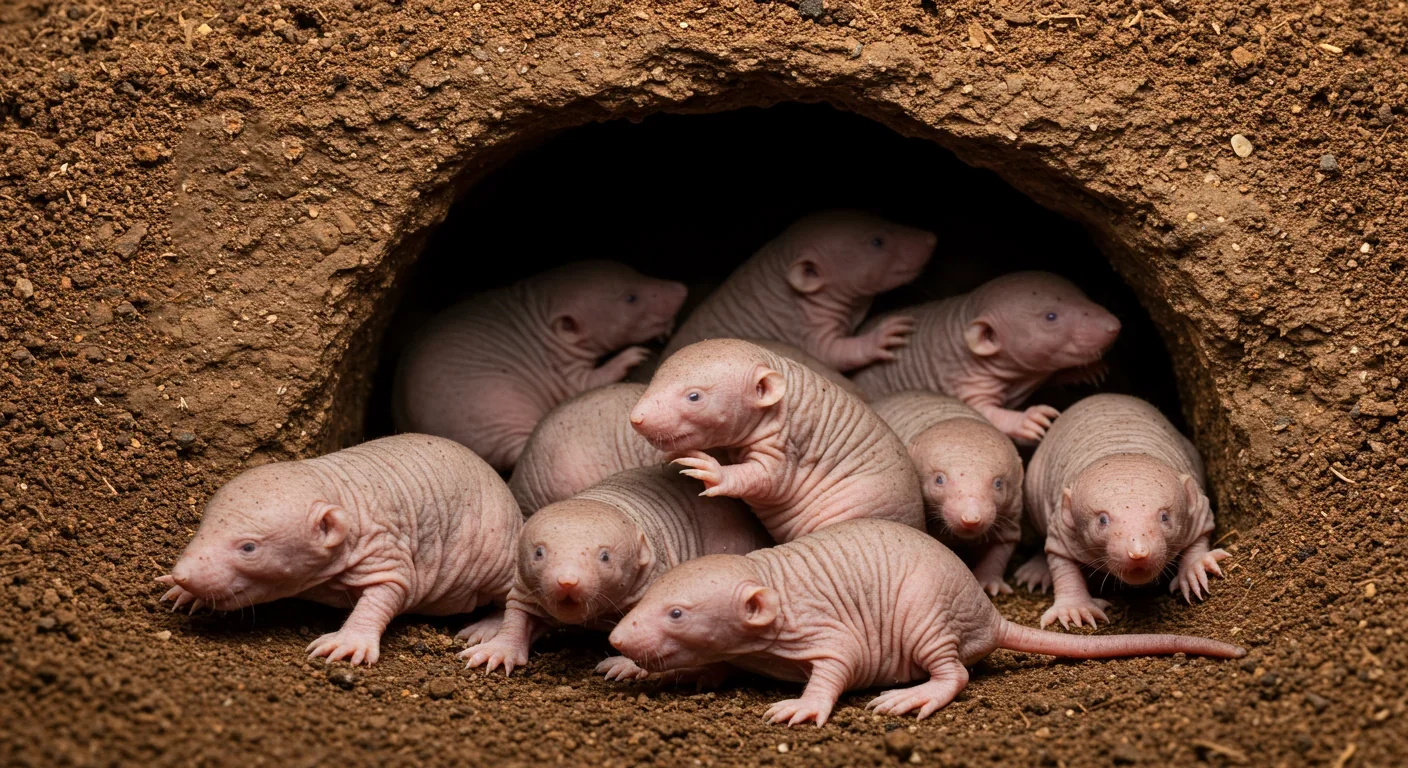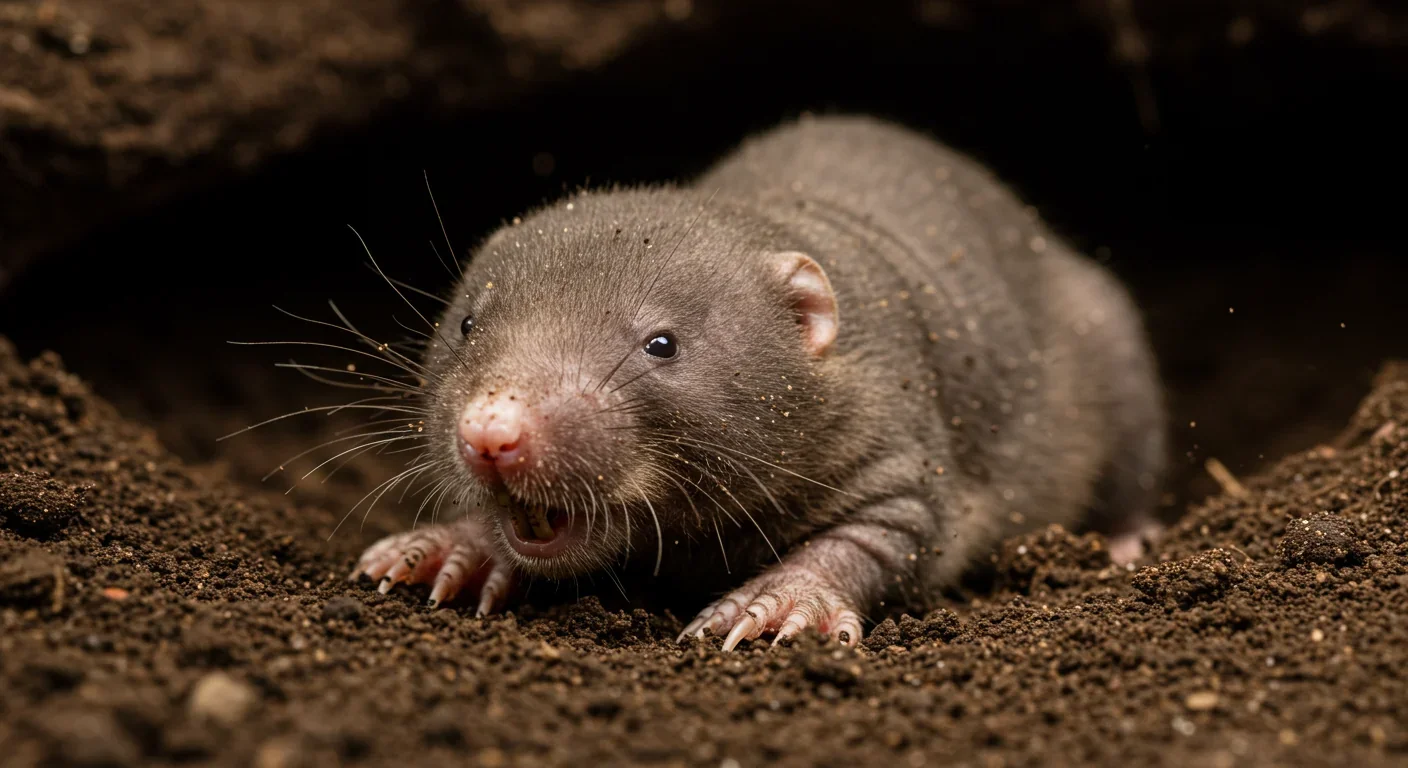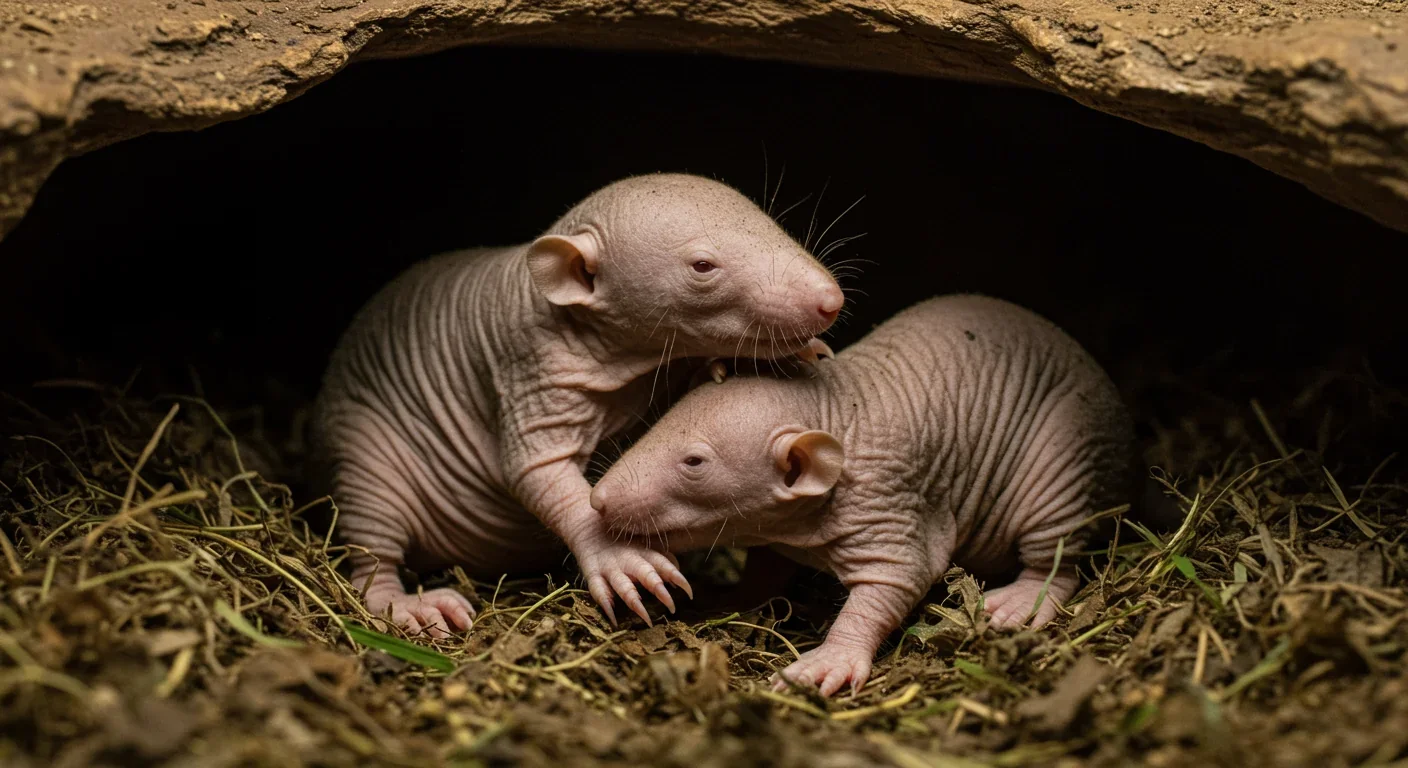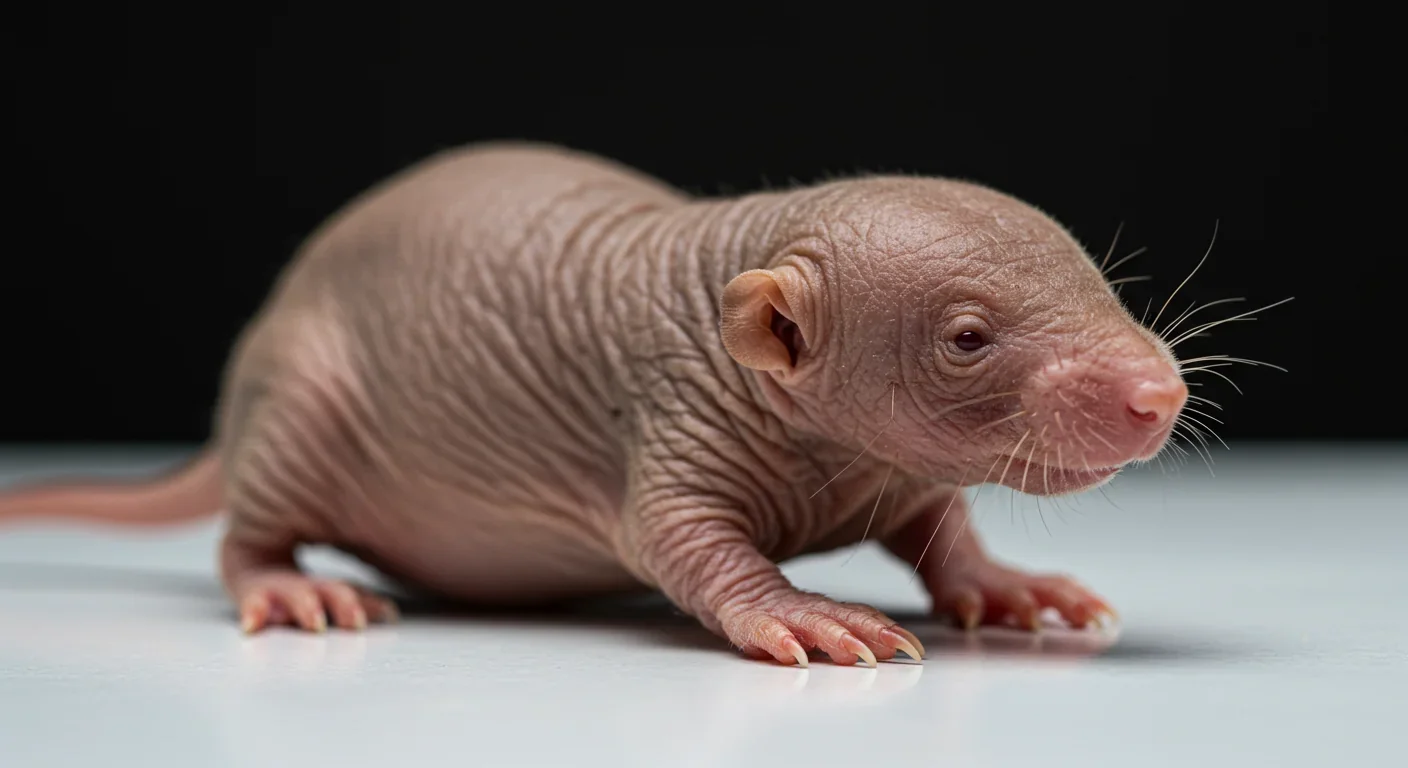Forest Biological Clocks: Ecosystems That Keep Time

TL;DR: Naked mole rats live in bee-like colonies with breeding queens and non-reproductive workers, exhibit negligible aging, resist cancer, and survive without oxygen for 18 minutes - revolutionizing our understanding of mammalian biology.

Deep beneath East African soil, something extraordinary is happening. Wrinkled, nearly hairless rodents are rewriting everything we thought we knew about mammalian social behavior. They live like bees. They age like they've discovered a biological fountain of youth. And they're forcing scientists to rethink fundamental questions about cooperation, aging, and disease resistance.
Welcome to the bizarre world of eusocial mole rats - the only mammals on Earth that have evolved a hive-like social structure previously thought exclusive to insects.
When biologist Jennifer Jarvis first described naked mole rat colonies in the 1970s, the scientific community was skeptical. Mammals don't live like insects. They don't have queens and workers. They don't sacrifice their own reproductive potential for the good of the colony.
Except these ones do.
In a single underground colony, up to 300 naked mole rats organize themselves into a rigid hierarchy. At the top sits a breeding queen - the only female who reproduces. She's larger, more aggressive, and maintains her position through chemical signals and physical intimidation. Below her are one to three breeding males who father all offspring. Everyone else? They're workers and soldiers, physiologically suppressed from reproduction and assigned specific jobs that serve the colony.
This social structure has a name: eusociality. It's the highest level of social organization in the animal kingdom. Before naked mole rats, we only saw it in insects like bees, ants, and termites.
The discovery shattered assumptions: Mammals are supposed to be individualistic, competitive, driven by personal reproductive success. These little rodents decided evolution had other plans.

So why did naked mole rats evolve this insect-like lifestyle when no other mammal did?
The answer lies in their habitat. East African underground tunnels are harsh, unpredictable environments where food is scarce and scattered. Finding a tuber large enough to sustain yourself is rare. Digging through hard, compacted soil is energetically expensive. And predators above ground make surface travel deadly.
Natural selection favored cooperation over competition. A single mole rat couldn't survive alone. But a coordinated colony that shares resources, divides labor, and maintains extensive tunnel systems? That works.
This is where kin selection theory becomes critical. Naked mole rats in a colony share about 80% of their DNA - similar to the genetic relatedness seen in honeybee hives. When workers help raise the queen's offspring instead of reproducing themselves, they're still passing on most of their genetic material. From an evolutionary perspective, sacrificing personal reproduction to support genetically similar relatives can be more successful than going it alone.
The Damaraland mole rat, a separate species in southern Africa, independently evolved the same social structure. This convergent evolution suggests that certain environmental pressures reliably produce eusociality when conditions are right.
Inside the colony, specialization is everything. Not all workers do the same jobs. Some are tunnel diggers, excavating new passageways with their prominent incisors. Others are transporters, moving excavated soil and food through the tunnels. There are colony defenders - soldiers with thicker skulls and larger bodies who attack intruders. And yes, there are designated toilet cleaners.
A 2024 study published in Science Advances used RFID tracking to monitor five captive colonies for 30 days. The researchers discovered that individual mole rats consistently performed the same tasks, rarely switching roles. This behavioral consistency mirrors the specialized castes seen in ant colonies.
But here's where it gets even weirder: these roles aren't genetically determined. Unlike insect castes, which are often locked in at birth, mole rat workers can change jobs if colony needs shift. Remove all the tunnel diggers, and some transporters will pick up shovels. It's flexible eusociality - a mammalian twist on the insect model.
The queen maintains control through multiple mechanisms. She produces pheromones that suppress reproduction in other females. She physically shoves and bullies subordinates, keeping them stressed enough that their reproductive systems remain dormant. And she's the only one who gets to mate, creating a genetic bottleneck where all colony offspring share her DNA.
"You can think of cGAS as a biological Lego piece - the same basic shape in humans and naked mole rats, but in the mole rat version a few connectors are flipped, allowing it to assemble an entirely different structure and function."
— Gabriel Balmus, clinical neuroscientist at University of Cambridge
Recent research revealed something surprising: in captivity, naked mole rats are actually monogamous. Queens mate with a single male for years, sometimes for life. This wasn't what scientists expected, since eusocial insects typically have queens mating with multiple males. Once again, these rodents are writing their own evolutionary playbook.

If eusociality were naked mole rats' only claim to fame, they'd still be fascinating. But evolution packed additional surprises into these wrinkled creatures that have scientists studying them for insights into human health.
First: they barely age. Most rodents live two to three years. Naked mole rats can reach 37 years old, with no increase in mortality rate as they age. They exhibit what researchers call "negligible senescence" - their bodies don't deteriorate the way ours do.
In 2024, Chinese researchers discovered why. They identified a mutation in a protein called cGAS. In humans and mice, cGAS inhibits DNA repair, increasing cancer risk. In naked mole rats, the mutated version actually supports DNA repair. As one researcher explained, it's like taking a biological Lego piece and flipping a few connectors to create an entirely different structure.
This helps explain their extraordinary cancer resistance. Despite living decades in crowded underground conditions, naked mole rats almost never develop tumors. Scientists have discovered they produce a unique high-molecular-mass hyaluronan that prevents cells from overcrowding - one of the early warning signs of cancer. When researchers removed this protection, cells became susceptible to cancer, proving its critical role.
Then there's their metabolism. Underground tunnels have low oxygen and high carbon dioxide levels - conditions that would cause brain damage in most mammals within minutes. Naked mole rats can survive 18 minutes without oxygen by switching to fructose-based metabolism, essentially functioning like plants. They can tolerate CO2 concentrations that would be lethal to humans.
Naked mole rats can survive 18 minutes without oxygen by switching their metabolism to use fructose instead of glucose - essentially functioning like plants in extreme conditions.
They don't feel certain types of pain. Their skin lacks substance P, a neurotransmitter that signals burning pain. This adaptation makes sense for animals living in high-CO2 environments that would normally trigger intense discomfort.
Their immune systems are unusual. They have fewer lymphocytes than other mammals but somehow maintain robust disease resistance. Their temperature regulation is impaired - they're nearly cold-blooded, which is almost unheard of in mammals. Even their lung structure shows adaptations for their underground lifestyle.

The naked mole rat has become a laboratory model for aging research, cancer studies, and metabolic investigations. Understanding how they resist tumors could inform new cancer therapies. Their longevity mechanisms might reveal interventions to slow human aging. Their oxygen-deprivation tolerance has implications for treating strokes and heart attacks.
In March 2024, researchers discovered that naked mole rats' unique metabolism protects them from heart attacks during low-oxygen events. This finding could lead to new treatments for cardiac patients.
The DNA repair mechanism discovered in 2024 is particularly exciting. If scientists can understand exactly how the mutated cGAS protein enhances cellular repair, it might be possible to develop therapies that mimic this effect in humans. We're talking about potential interventions for aging, cancer, and degenerative diseases.
But there's another dimension to naked mole rat research: understanding cooperation itself. These animals prove that mammals can evolve extreme altruism and self-sacrifice under the right conditions. Some researchers have even asked whether humans might be classified as eusocial, given our complex societies, division of labor, and cooperative child-rearing. While we don't meet the strict biological definition, studying how eusociality evolved in mole rats provides insights into how cooperation shapes social evolution across species.
For decades, scientists debated how eusociality could evolve. How does natural selection, which typically favors individual reproductive success, produce organisms that give up reproduction to serve others?
In 2010, research published in Nature challenged previous explanations. The study argued that natural selection alone - without requiring kin selection theory - could explain eusociality. The key factors: ecological constraints that make solitary life nearly impossible, benefits of group living that outweigh costs, and environments where cooperation dramatically increases survival odds.
This sparked debate that continues today. Different researchers emphasize different mechanisms: genetic relatedness, environmental pressures, bet-hedging strategies in unpredictable habitats. The truth likely involves multiple interacting factors.
What's clear is that naked mole rats aren't following a predetermined insect blueprint. They're creating their own version of eusociality, adapted to mammalian biology. They retain flexibility insects lack. They live much longer. They can potentially reverse their worker status if circumstances change. They're proof that evolution can arrive at similar solutions through completely different paths.

The more scientists study these animals, the more questions emerge. How exactly do queen pheromones suppress reproduction in workers? What genetic changes enabled their dramatic life extension? Why did eusociality evolve in only two mammal species out of over 6,000? How do colonies maintain genetic diversity despite inbreeding?
Recent 2024 research on Damaraland mole rats examined workload distribution in wild colonies, revealing that even in natural settings, specialized roles persist. This confirms that laboratory observations reflect genuine evolutionary adaptations, not artifacts of captivity.
The naked mole rat challenges neat categories. It's a mammal that lives like an insect. It's a cold-blooded creature that still produces some internal heat. It's an animal that has nearly defeated aging and cancer - problems that seem inevitable in complex organisms.
For researchers, these rodents represent a natural experiment in what's biologically possible. Every discovery raises new possibilities for medicine, genetics, and evolutionary biology.
Why did eusociality evolve in only two mammal species out of over 6,000? The answer may lie in the unique combination of harsh underground environments and unpredictable food sources that made cooperation the only viable survival strategy.
The scientific community's interest in mole rats is accelerating, not slowing. New studies emerge regularly, each revealing additional layers of complexity. The 2024 cGAS discovery that could "change human longevity forever" is just one example of how these animals continue to surprise us.
As laboratory techniques improve, researchers can ask increasingly sophisticated questions. How do gene expression patterns change across different worker roles? What molecular signals coordinate colony behavior? Can we identify the specific mutations that enabled their longevity and cancer resistance?
Conservation is also a consideration. While naked mole rats aren't currently endangered, their highly specialized lifestyle makes them vulnerable to habitat destruction. Understanding and protecting these unique animals isn't just about preserving biodiversity - it's about maintaining a living laboratory that could unlock solutions to some of humanity's greatest health challenges.
The naked mole rat proves that nature still has the capacity to astonish us. In the darkness beneath East Africa, evolution conducted an experiment that produced something unprecedented: a mammal that organized itself like a beehive, defeated the aging process, and became nearly immune to cancer.
These wrinkled, buck-toothed rodents may not win beauty contests. But they're teaching us that the boundaries of what's biologically possible are far wider than we imagined. And they're doing it by simply being what millions of years of evolution designed them to be: the most cooperative, longest-lived, cancer-resistant mammals on Earth.
Not bad for something that looks like a walking thumb.

MOND proposes gravity changes at low accelerations, explaining galaxy rotation without dark matter. While it predicts thousands of galaxies correctly, it struggles with clusters and cosmology, keeping the dark matter debate alive.

Ultrafine pollution particles smaller than 100 nanometers can bypass the blood-brain barrier through the olfactory nerve and bloodstream, depositing in brain tissue where they trigger neuroinflammation linked to dementia and neurological disorders, yet remain completely unregulated by current air quality standards.

CAES stores excess renewable energy by compressing air in underground caverns, then releases it through turbines during peak demand. New advanced adiabatic systems achieve 70%+ efficiency, making this decades-old technology suddenly competitive for long-duration grid storage.

Our brains are hardwired to see patterns in randomness, causing the gambler's fallacy—the mistaken belief that past random events influence future probabilities. This cognitive bias costs people millions in casinos, investments, and daily decisions.

Forests operate as synchronized living systems with molecular clocks that coordinate metabolism from individual cells to entire ecosystems, creating rhythmic patterns that affect global carbon cycles and climate feedback loops.

Generation Z is the first cohort to come of age amid a polycrisis - interconnected global failures spanning climate, economy, democracy, and health. This cascading reality is fundamentally reshaping how young people think, plan their lives, and organize for change.

Zero-trust security eliminates implicit network trust by requiring continuous verification of every access request. Organizations are rapidly adopting this architecture to address cloud computing, remote work, and sophisticated threats that rendered perimeter defenses obsolete.